You are about to make the easiest Nasi Kunyit. Translating to “Turmeric Rice” in English, this simple rice preparation marries the warmth of turmeric with fragrant steamed sticky rice and Indonesian herbs. The rice is steamed rather than boiled and requires no additional oil.

Along with Nasi Uduk, and Nasi Minyak, Nasi Kunyit is part of the holy trinity of Indonesian rice. Turmeric, a star ingredient in this recipe, not only imparts a beautiful yellow color to the rice but also offers a wealth of health benefits, known for its anti-inflammatory properties. Its vibrant color is intensified by lime juice.
What sets my Nasi Kunyit recipe apart is its foolproof approach, ensuring you will conquer this dish on your first try. I’ve carefully crafted these instructions to ensure you easily navigate the process, from selecting the right rice to achieving the perfect balance of spices.
Grab your steamer, and let’s get your dinner made together!
Jump to:
🥰Why you are going to adore the ever-loving heck outta this recipe
✊Vegan AF: Nasi Kunyit is traditionally 100% plant-based. It’s full of flavor without being full of cholesterol or causing harm to animals and the environment. No shrimp paste, or chicken stock to be found here!
🏆Fail-proof Method: Nail it on your first attempt, even if you’re new to Indonesian cooking. My clear step-by-step instructions take the guesswork out, ensuring your Nasi Kunyit turns out delicious and authentic.
✅Tested and Approved Worldwide: Like all the recipes on my blog, this turmeric steamed rice has been meticulously fine-tuned not only by me but by a team of dedicated recipe testers from around the world, including in Indonesia, where the dish was born. No matter where you are on the planet, rest assured it’s been tested to work everywhere!
🍚Notable ingredients and substitutions

Glutinous Rice (Sweet Rice)
A staple in Indonesian cuisine, glutinous rice brings a delightfully chewy texture to Nasi Kunyit. Don’t be misled by the name - it’s gluten-free! In a pinch, you can substitute with short-grain white rice. Don’t know what else to make with the bag of glutinous rice you just got to make this recipe? Make some Vietnamese Taro Rice Pudding.
Turmeric
You can use either turmeric powder or freshly grated turmeric root to make this rice. It’s also a main ingredient in lotus seed curry. Turmeric boasts anti-inflammatory properties and gives rice dishes like this one, namsi minyak and Indian biryani their stunning hue. The lime juice in this recipe also serves to enhance turmeric’s color.
Lime
Beyond its tangy flavor, its acidity prevents the turmeric from becoming dull, ensuring the nasi kunyit maintains its stunning golden appearance. If limes are scarce, lemon juice is a fine substitute. In the recipe, both lime juice and slices are added to the soaking rice. This is so some of the nice flavors from oils in the skin into the rice.
Indonesian Bay Leaf
Known as “Daun Salam” in Indonesia, the Indonesian bay leaf is a subtle yet impactful ingredient in Nasi Kunyit. Unlike the Mediterranean bay leaf, it has a citrusy and earthy aroma that adds depth to the dish. If you don’t have access to Indonesian bay leaves, you can use Mediterranean bay leaves in their place.
Makrut Lime Leaves
These aromatic leaves, often referred to as “Kaffir Lime Leaves,” infuse Nasi Kunyit with a distinctive citrusy fragrance. The term “Kaffir” has derogatory connotations in some regions, so it’s respectful to use the term “Makrut” instead. These leaves are a hallmark of Southeast Asian cuisine, adding a unique layer of flavor to everything from Tahu Goreng to Tom Yum paste. If you’re unable to find fresh Makrut lime leaves, dried ones can be a suitable substitute, though their potency might differ.
*See the recipe card at the bottom of the page for exact quantities, nutritional info, and detailed cooking directions.
🤯Variations
Stir-Fried Nasi Kunyit with Pickled Carrot and Chinese Broccoli: Turn nasi kunyit into a hearty stir-fry with stir-fried pieces of carrot pickle or green chili pickle and nourishing Chinese broccoli. SUCH a yummy fried rice vibe.
Nasi kuning: simply use jasmine rice in place of the sweet rice, and add a crushed stalk of lemongrass to the steaming rice.
📖Step-by-step instructions
Make this perfectly by following these step-by-step instructions with important tips. Or you can follow along with the easy-to-print recipe card towards the bottom of this page.
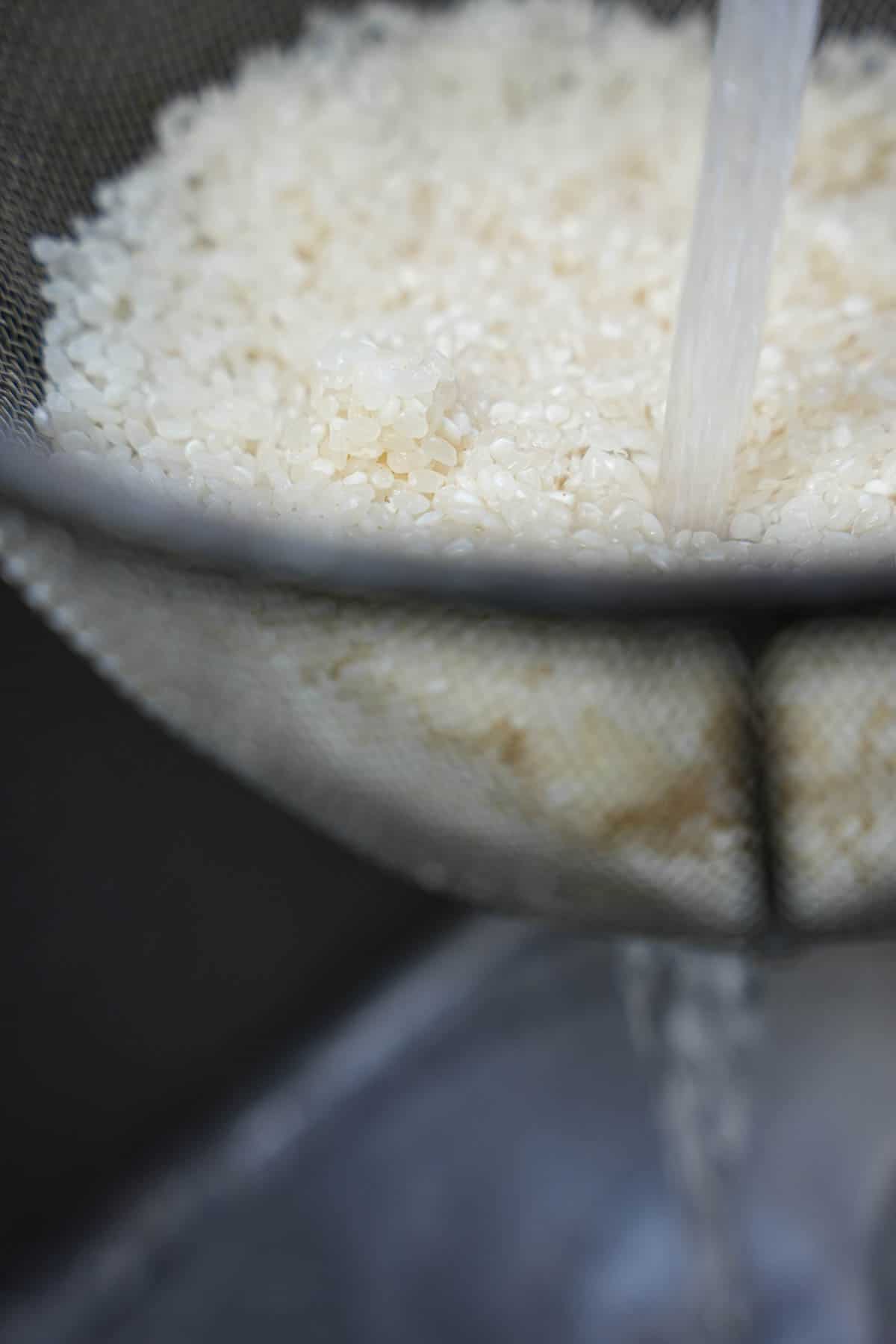
Step One
Rinse the glutinous rice under cold water until the water runs clear. This helps remove excess starch for a better texture.

Step Two
Transfer the rinsed rice to a container. Stir in enough water to cover the rice, along with turmeric, lime juice, and a pinch of salt. Add a few slices of lime so that the oils from the skin are absorbed by the soaking rice. Allow the rice to soak for at least 4 hours or, for best results, let it soak overnight.

Step Three
After soaking, remove the lime slices and drain (but don’t rinse) the rice using a wire mesh strainer.
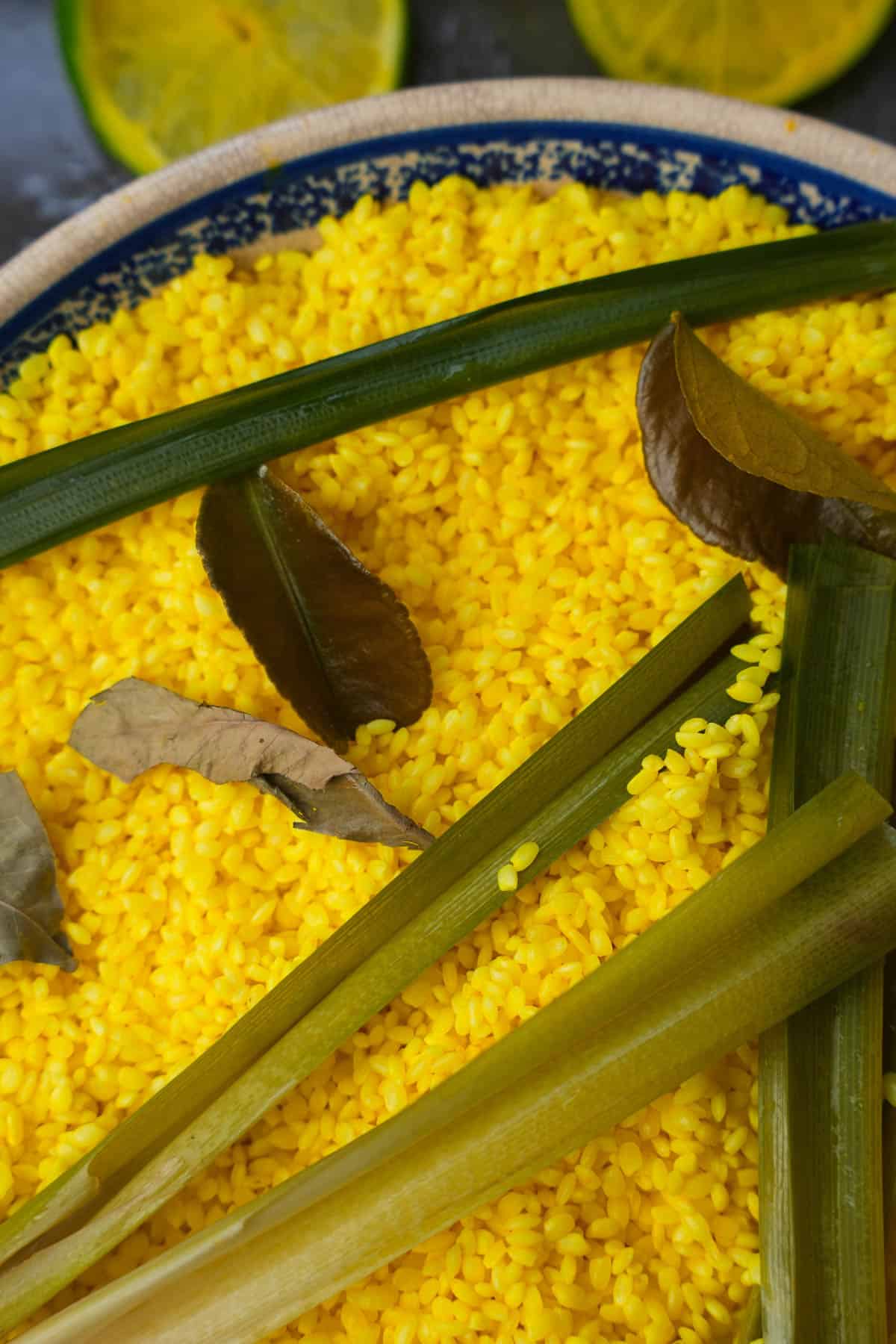
Step Four
Transfer the vibrant yellow rice to a shallow plate or cake pan. Stir in white pepper, and add pandan leaves, makrut lime leaves, and Indonesian bay leaf.
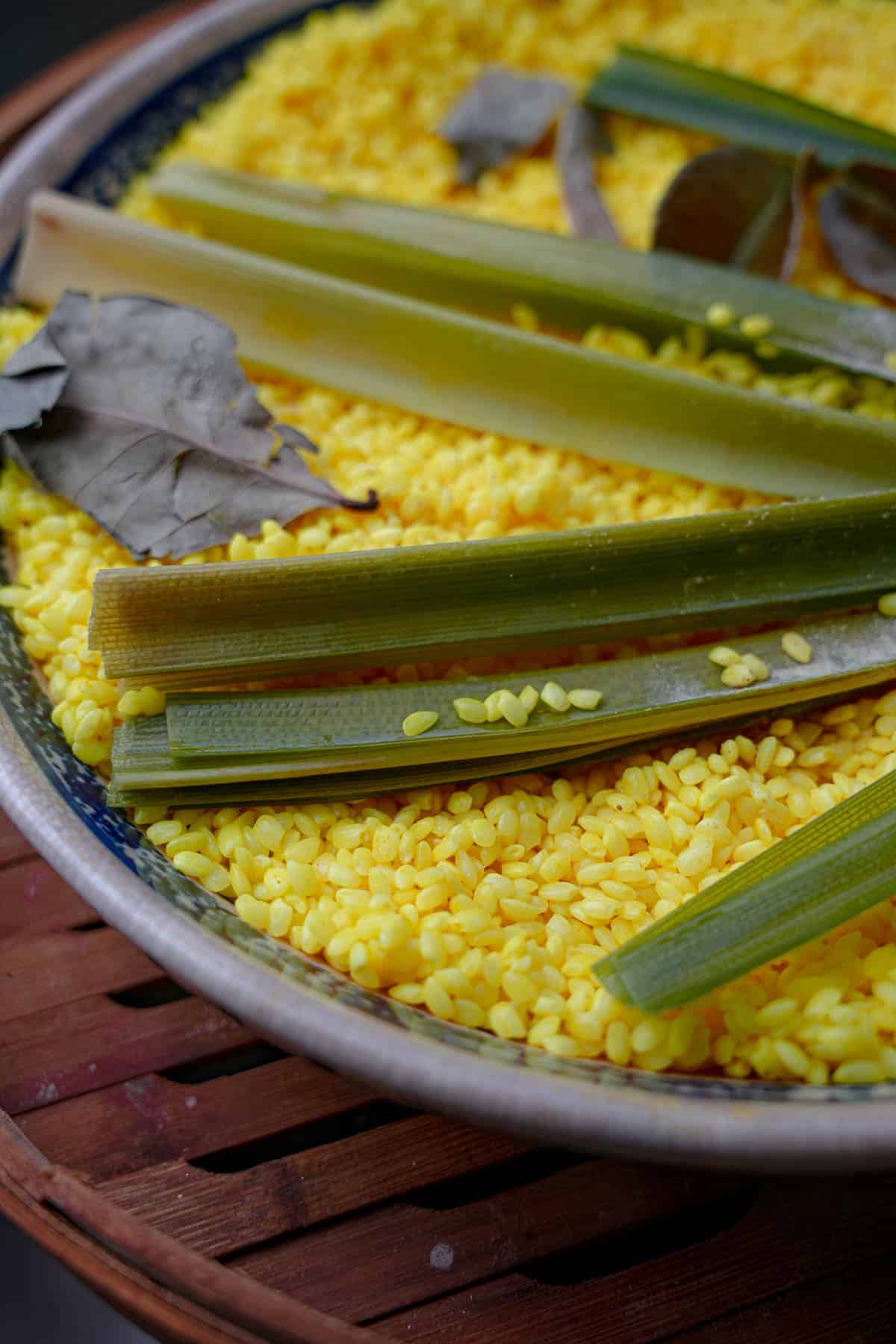
Step Five
Steam the rice over medium heat for 35 minutes.

Step Six
After the initial steaming, drizzle the coconut milk around the surface of the rice, and steam for an additional 5 minutes, allowing the coconut milk to become absorbed by the rice.
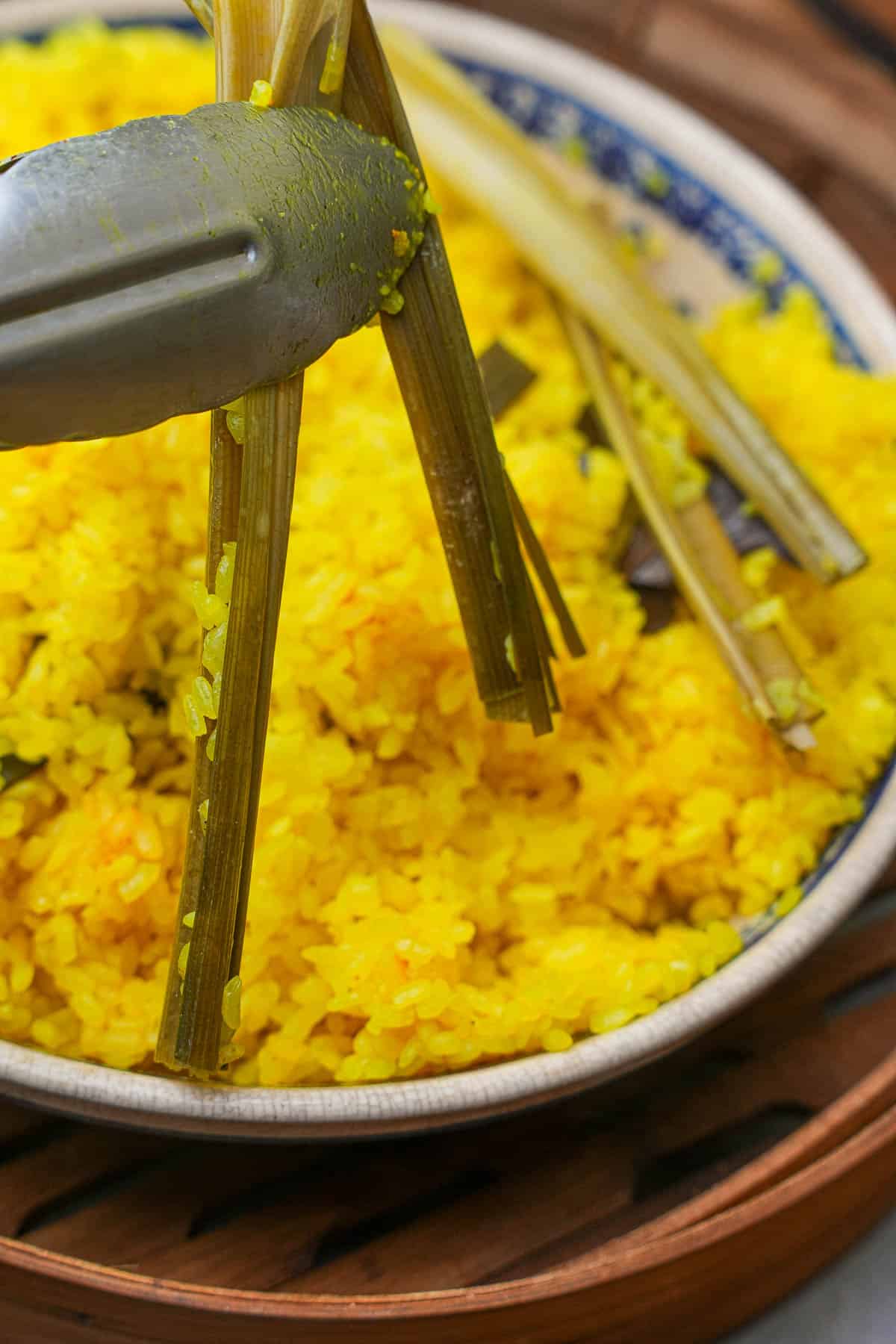
Step Seven
Once the steaming is complete, remove the pandan leaves, bay leaf, and makrut lime leaves from the turmeric glutinous rice. Gently fluff the rice using a fork before serving. This step ensures the rice grains are separated and the flavors are evenly distributed throughout the dish.

Step Eight
Optionally garnish the rice with freshly sliced chilies, scallions, and herbs and serve it alongside some veggies like urap sayur, or a tall hot mug of bandrek!
💡Serving Ideas
Nasi Kunyit can be the basis for an unforgettable meal!
Try the crispy texture of rice dumplings, chee cheong fun, or serve it with seitan fried chicken glazed in Korean BBQ sauce.
Serve warm with tofu sisig or savor the harmony of vegan bulgogi alongside homemade kimchi and Korean cucumber salad. Smash a bowl of Nasi kunyit with pickled burdock, and mie goreng!
Finish with a classic Southeast Asian dessert like martabak manis, kuih dadar, che ba, banh flan, klepon, tupig, or taro pudding.
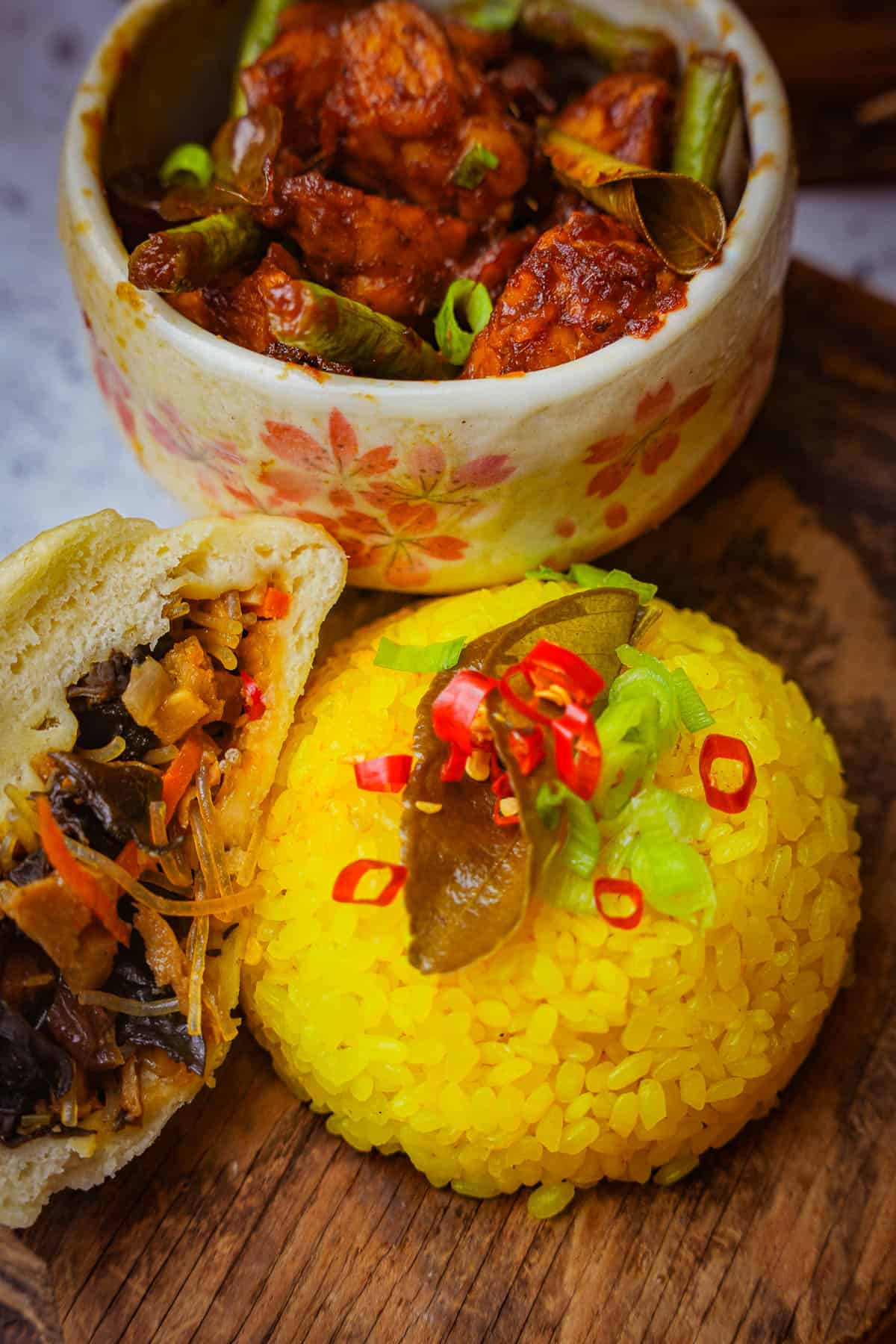
👉Top tip
Rinse and Soak: Rinse glutinous rice thoroughly to remove excess starch. When soaking, let the rice absorb the turmeric, lime juice, and flavors for at least 4 hours or overnight for the best results.
Steaming Technique: When steaming, arrange the rice in a shallow layer. A pie pan, plate or cake pan might be the right vessel, depending on the size of your steamer.
Drizzle coconut milk: This adds creaminess and helps carry the flavor as this rice has no oil or fat.
After steaming, gently fluff the rice with a fork before serving. This separates the grains and ensures an evenly seasoned and textured dish.
Don’t eat plain-ass rice! Experiment with accompaniments like miso glazed eggplant, black chickpeas, pickled mango or chana masala with Nasi Kunyit.
🤷♀️FAQ
Glutinous rice is recommended for its sticky texture, but you can substitute it with short-grain rice for a different texture.
Soaking is crucial for flavor infusion and rice softening since it is being cooked in a steamer and not boiled.
Over-steaming can lead to mushy rice, but if you check it and it doesn’t seem done, steam it a bit longer until tender.
Freezing and thawing will ruin the delicate texture of the rice. It’s best enjoyed fresh, but you can refrigerate for a day or two.
🥶Refrigeration:
Once you’ve relished your Nasi Kunyit, store any remaining portions in an airtight container. Keep it refrigerated to maintain its quality. Consume within two days.
🔥Stovetop Reheating:
Place a non-stick pan on the stove over medium heat.
Add a dash of water or unsalted vegetable stock to the pan.
Add the Nasi Kunyit to the pan, and stir occasionally as it warms, ensuring even heating.
☢️Microwave Reheating:
Transfer a portion of your Nasi Kunyit to a microwave-safe dish.
Cover the dish with a microwave-safe lid or plate.
Microwave on medium power for 30-second intervals.
Pause after each interval to stir the dish.
This approach ensures thorough reheating without compromising the texture.
I particularly love serving soya chaap sabji, jackfruit curry, and ridge gourd curry with turmeric rice as part of a thali platter.
🍚 My faves to make with Nasi Kunyit:
Say Hi on Social! 👋
Follow me on Instagram & Facebook for more recipes.
❤️Love this recipe? It helps me out greatly if you leave a 5-star 🌟🌟🌟🌟🌟rating in the recipe card below and maybe even leave me a lovey-dovey comment too!

Nasi Kunyit (Indonesian Turmeric Rice, 黄姜饭)
Equipment
- Cake pan, or pie pan
Ingredients
- 2 cups glutinous rice
- 2 teaspoons turmeric powder or 1 tablespoon freshly grated turmeric
- 1 tablespoon lime juice
- 1 lime sliced
- 1 teaspoon salt
- ¼ teaspoon white pepper
- 3 pandan leaves
- 2 makrut lime leaves optional
- 2 Indonesian bay leaves or regular bay leaves
- ⅔ cup coconut milk
Instructions
- Rinse glutinous rice under cold water until water clears.
- Place the rice in a container and, stir in water to cover, turmeric, lime juice, lime, and salt. Soak rice for at least 4 hours or overnight.
- Remove lime slices, and drain rice in a wire mesh strainer.
- Move the yellow rice to a shallow plate or cake pan if your steamer is large enough to accommodate it. Add pandan leaves, market lime leaves, white pepper and bay leaf.
- Steam over medium heat for 35 minutes.
- Drizzle coconut milk around the surface of the rice and steam for 5 more minutes.
- Discard pandan, bay leaf, and makrut lime leaves, and fluff the rice with a fork before serving.

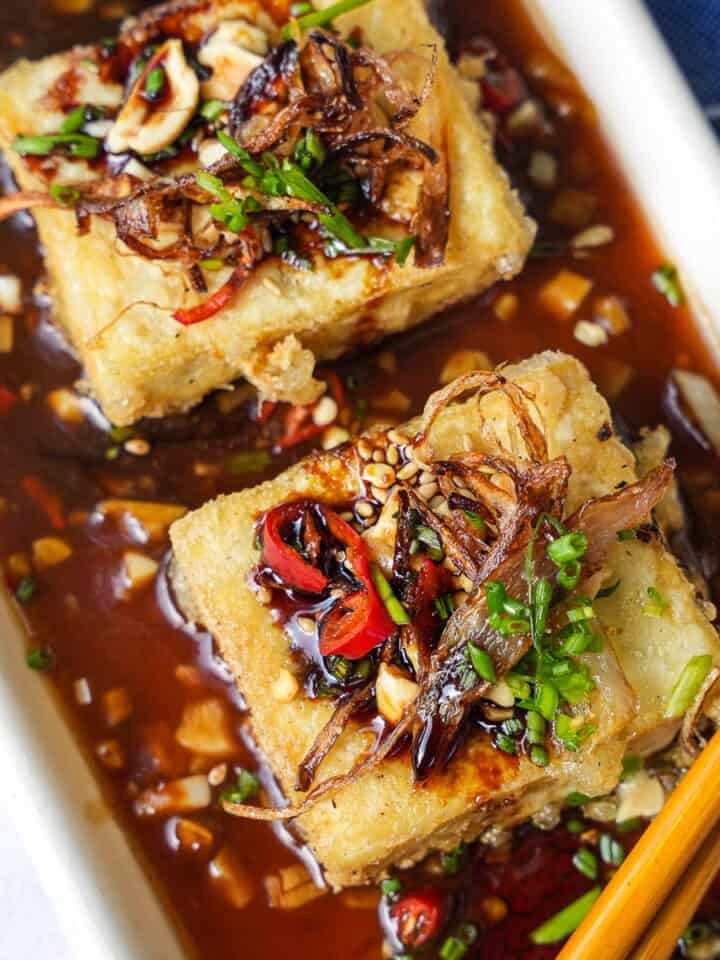
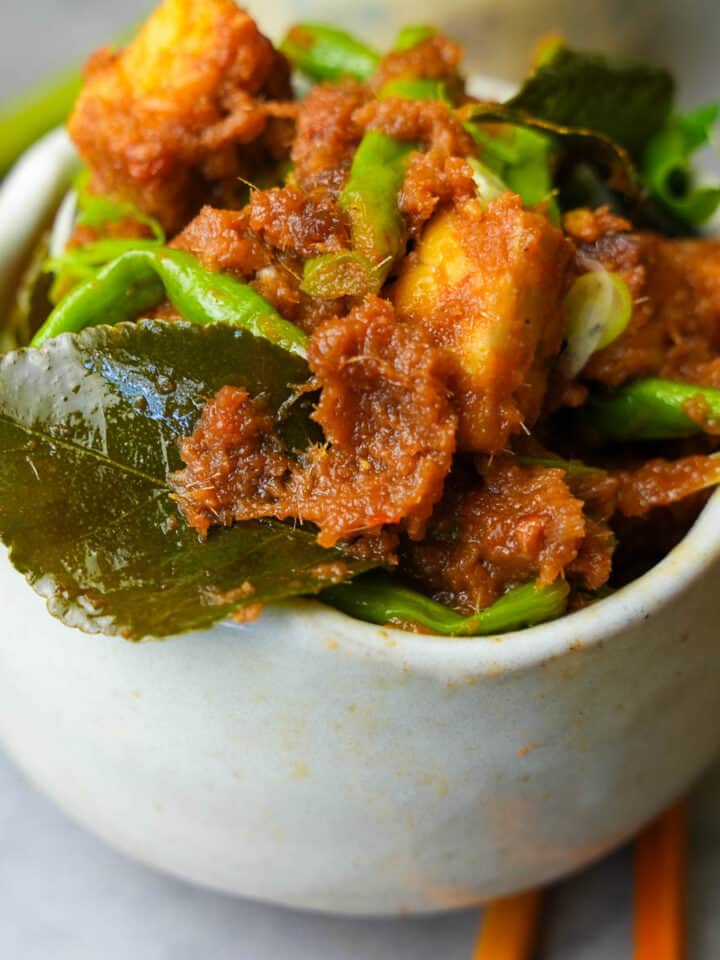


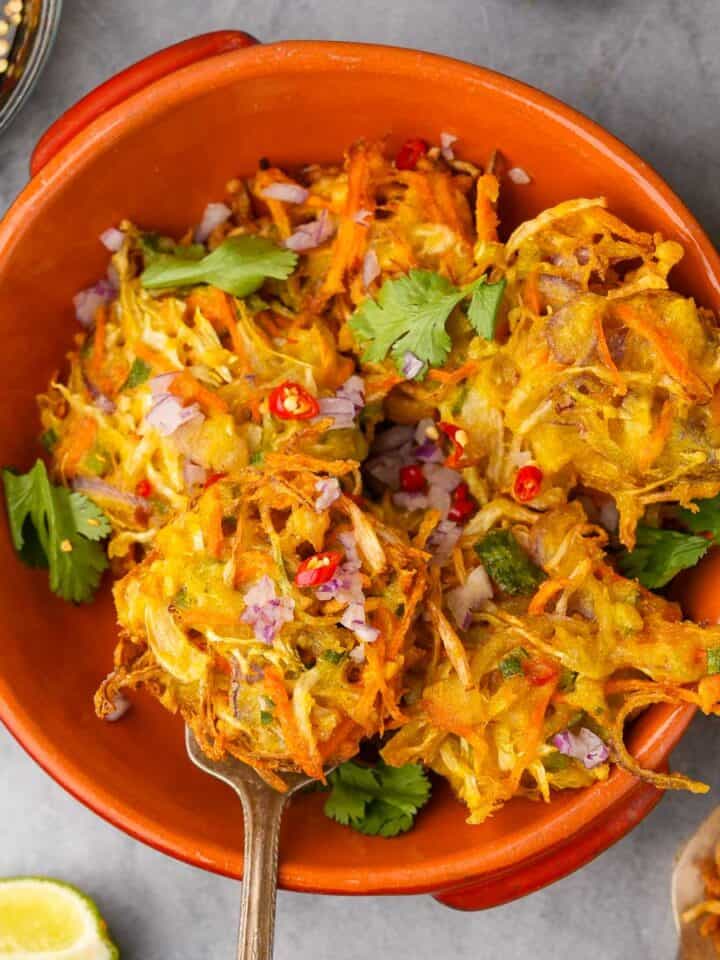
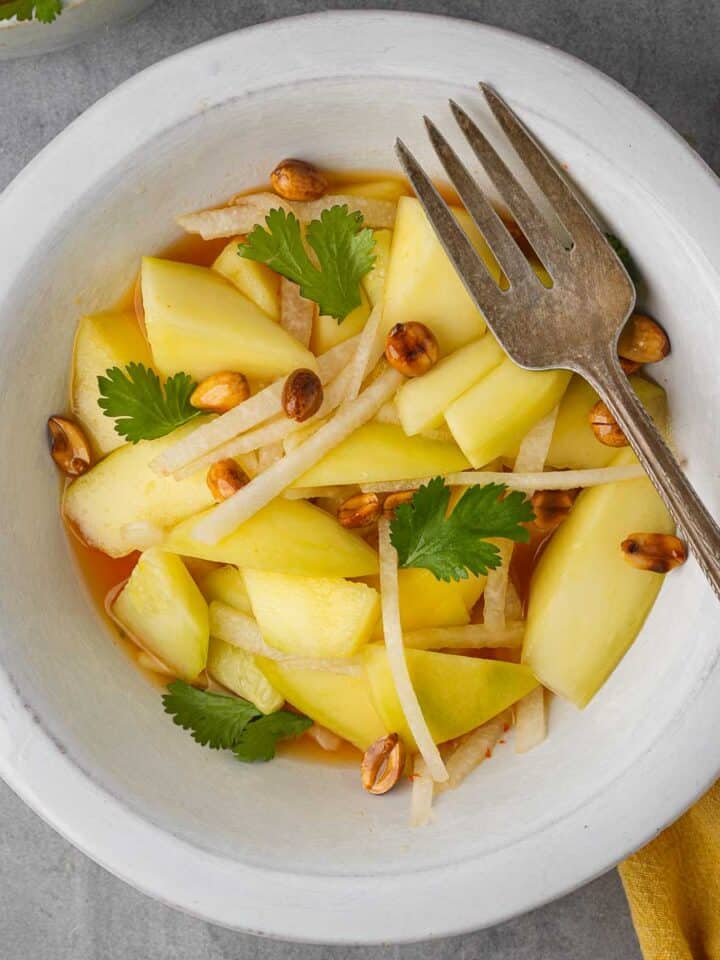
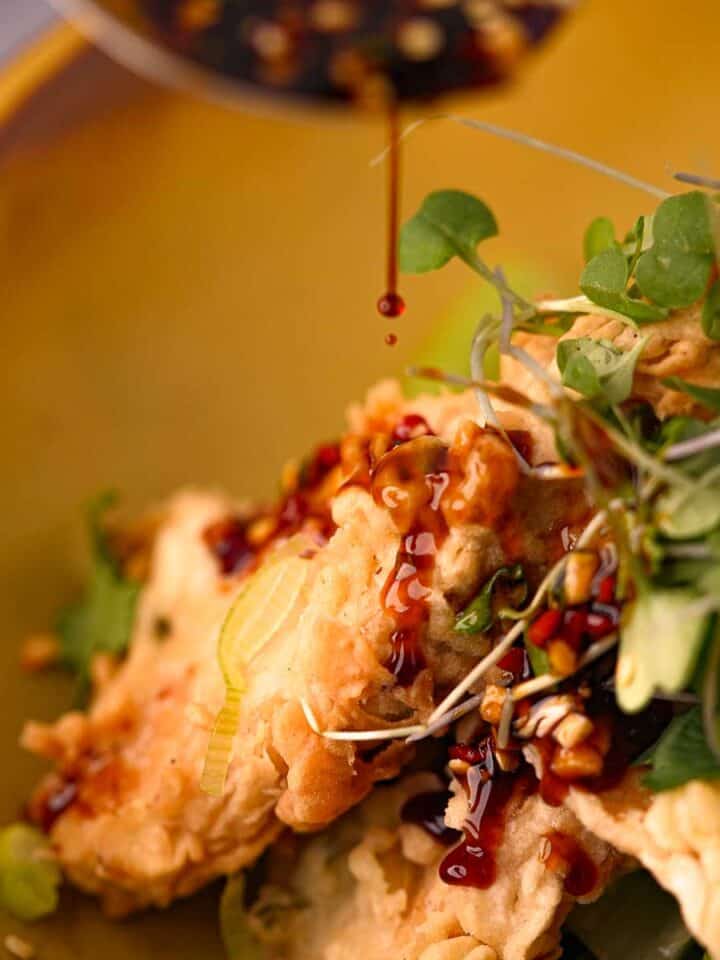
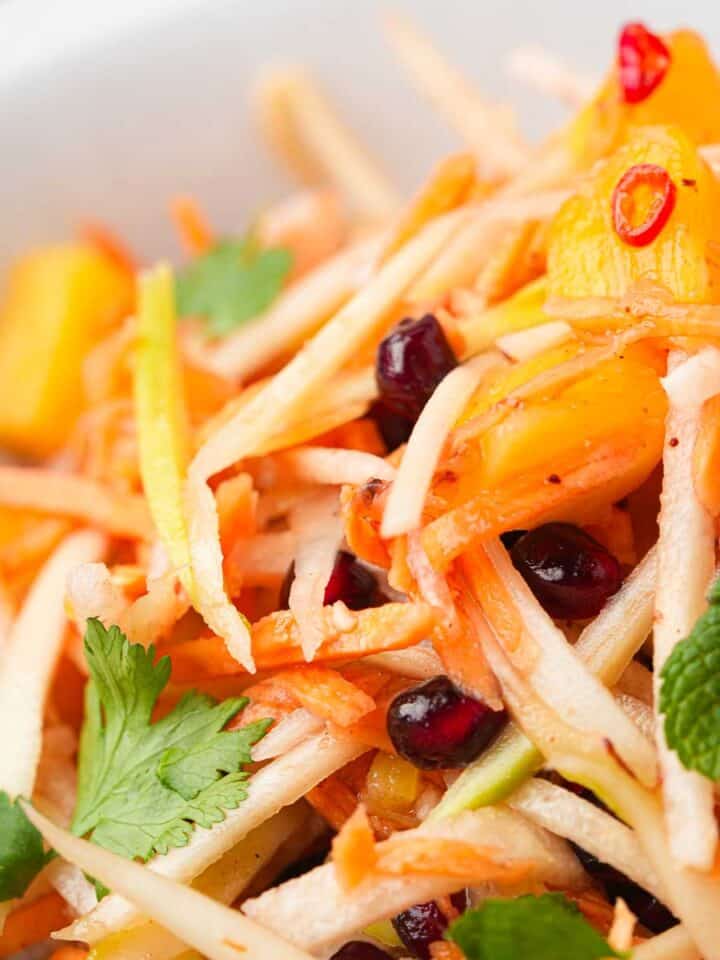

Leave a Reply